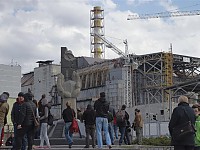This post may contain affiliate links. We may earn money or products from the highlighted keywords or companies or banners mentioned in this post.

Crisis areas, tours around battlefields, slums – why do people travel to places of unimaginable horror? Why do they sacrifice their yearly vacation to look at the misfortune of others? Researchers explain the rising popularity of dark tourism.
As of recently, a Ukrainian agency offers trips inside the contaminated area of the Chernobyl nuclear power plant. Roughly 200 Euros will give the visitors a guided tour to the restricted area, 30 kilometers around the damaged reactor of the nuclear catastrophe of 1986. The stops on these sightseeing tours include a visit to the reactor and a walk through the ghost town of Pripjat.
Why do people visit these places of unimaginable horror? Why do they sacrifice their yearly vacation to look at the misfortune of others? And on top of all: why do they bring themselves in such danger?
Chernobyl Visit as a Test of Courage
“They are usually young men between 20 and 30 years, who are looking for thrills and film themselves with a Geiger counter in the other hand, waiting for it to deflect,” Professor Heinz-Dieter Quack explains.
“For some, it’s kind of a test of courage,” the researcher at the Ostfalia Hochschule for applied Sciences Braunschweig/Wolfenbüttel said. “Since we hardly have any existential fears in our daily lives, some tourists seem to actively look for similar experiences for thrills.” And indeed, trips to the restricted area are booming, commented Quack, who has been looking into the phenomenon of “Dark Tourism” for quite some time.
However, this term encompasses more than one might think: “Dark tourism is anything, which does not fit into our positive-naive image of holidays,” the researcher at the institute of tourism and regional research remarked. For example, this would also include a vacation without exclusively positive experiences, such as a regular holiday that includes a visit of a former war area or prison. The scientist added that this form of dark tourism may also have honorable motivations.
After all, many vacationers share the motive of education: “They want to come to their own conclusions without relying on the media,” Quack said.
Martin Lohmann, chief scientist at the Institute of Tourism and Spa Research in North Europe called attention to the monitory effects of trips to concentration camps or WWII memorials. They can give visitors a very powerful impression of the dreads that came with the Nazi regime. Lohmann remarked that this kind of dark tourism was indispensable.
A Visit to Crisis Areas for Self-elevation
Still, there are also dark tourists, who revel in the pain of others. “Some people visit disaster zones, such as the earthquake regions of Haiti, in order to elevate themselves,” says Quack. “This can be compared to rubbernecking at the scene of a highway accident,” the tourism researcher continued. “They pretend to be concerned, but are only there to tell themselves: ‘How great that this didn’t happen to me’.”
This kind of voyeuristic impulse brought a great rush of visitors to the island of Giglio after the Costa Concordia incident, Quack explained. “I don’t think all those visitors are there to mourn their relatives.”
Many scientists also attribute slum tourism to dark tourism. But even in this case, Quack mentioned, one shouldn’t condemn these tourists. It all comes down to the reason why people visit these shantytowns. Travelers should ask themselves: “Am I seriously interested in the conditions these people live in?” Doing so could very well be better than lying at the pool of an all-inclusive hotel and ignore the living standard of the inhabitants. “Or do I just want to feel better about myself by looking at the suffering of others?”
Those who take selfies are usually concerned about themselves the most. “Look, I’m at the Eiffel tower.” But: “Look, I’m in a Favela”. Is that right? Should shanty towns or the consequences of a nuclear catastrophe serve as the background of one’s own ego? Like a tropic wallpaper?
What’s clear is that dark tourism is around much longer than we think. It’s not a recent movement caused by the generation of selfie: “Even ancient Greek and Roman visitors inscribed their names, places of origin and dates in stone at the Egyptian Valley of Kings,” said Quack.










